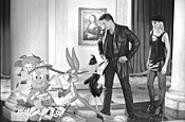
Wherever they were, the Looney Tunes are here again, in a feature film that crams as many of them as possible into a live-action world otherwise populated by actual humans (though sometimes it's hard to tell). The joke, as it was in Roger Rabbit, is that the Tunes are movie stars, with all of the attendant egotism, paranoia, and celebrity status that accompany that station. The problem, evident from the opening scene, is that the creators haven't bothered to invest the human beings with half as much depth as their two-dimensional counterparts. Instead, the flesh-and-blood actors are largely set pieces against which the Tunes display their vaudevillian wit.
The result? Looney Tunes: Back in Action is a zany, mind-numbing, achingly post-modern advertisement for itself, which attempts to distract us from its highly merchandised nature by constantly referring to it.
The plot, essentially an excuse to string gags together, pits Daffy Duck against his longtime nemesis, Bugs Bunny. The duck wants to shed his role as the rabbit's whipping boy and grab a place at the top of the credits. Instead, showing a low audience-approval rating, he's given the boot. DJ Drake (Brendan Fraser), the security guard charged with removing Daffy from the lot, is summarily fired as well. No matter: The two soon drop into another plot, in which DJ must rescue his movie-star father from the clutches of Mr. Chairman (Steve Martin, doing Urkel), the evil head of the Acme Corporation. In Las Vegas. Road trip!
The ensuing shenanigans involve Kate Houghton (Jenna Elfman), a humorless studio exec whose job depends on retrieving Daffy; the aforementioned Mr. Chairman, flanked by his board of Vice Presidents (including the VPs of Child Labor and Never Learning); and Joan Cusack as a perky, lovable, top-secret scientist named Mother. Oh, and some Tunes. Lots of Tunes. Lots and lots and lots of Tunes. When Michigan J. Frog has a cameo, you know you're getting the whole product line.
Also starring in this movie are untold numbers of pop-cultural icons, including Elvis, Sinatra, the Mona Lisa, Star Wars, Nemo, Batman, and, if Jenna Elfman's hair is an indication, Farrah Fawcett. In fact, the entire film is an homage to James Bond -- an odd choice, considering that Austin Powers has depleted pretty much all the comic mojo from that franchise. But then, Looney Tunes: BIA is about its own derivativeness. Again and again, it points to its use of previously owned characters, plots, and gags with a knowing wink, inviting us to enjoy the pleasure of complicity. It's funny, now and then, but it's dangerously thin. We're supposed to feel clever because we're in on the joke, but the joke is on us: As complacent consumers of popular culture, we're not worthy of anything new.
Looney Tunes: BIA's stance is one of sophisticated self-knowledge, but if the film truly knows itself, its audacity is shocking. Unlike the typical Bond-style plot, here the villain does not seek to destroy the world. Instead, the Acme Corporation intends to convert all human beings into monkeys, who will slave away at creating inferior Acme products. Later, when the products have been produced, the company will transform the monkeys back into humans to buy these products at exorbitant prices.
Slave wages, inferior products, rampant consumerism: Is this different from what Warner Bros. is doing? Where are the merchandising tie-ins manufactured? How much are we paying for them? How much, that is to say, do we fork over to Warner Bros. so that we can advertise its goods? Doesn't the sheer verticality of the WB's product line, including various media whose consumption encourages the purchase of consumer goods that in turn advertise the media, suggest a kinship with the very Acme Corporation that the movie portrays as evil? (Never mind the product placement for Wal-Mart, the largest retailer in the United States; the movie makes a joke of that as well.) It's problematic, to say the least, but because the Looney Tunes wink and nudge, we're supposed to laugh it off. Then we're supposed to visit the online store for some Tunes-related trinkets.
In other words, it's morally corrupt, but your kids will love it.

